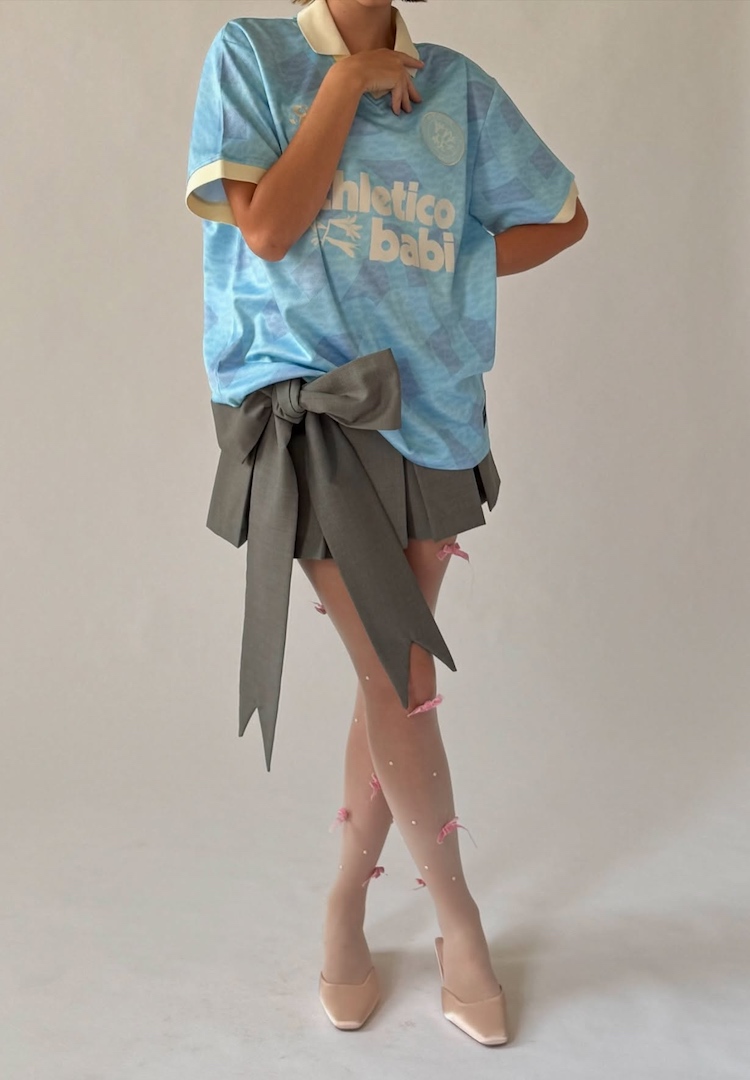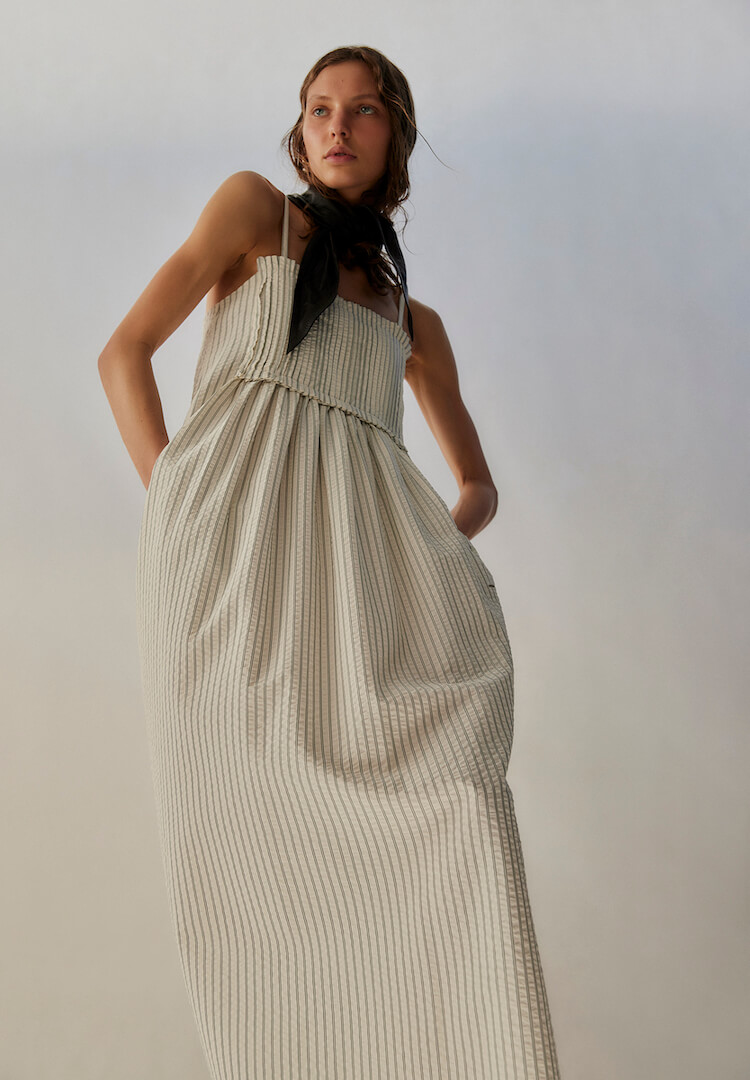Melbourne fashion label A.BCH is setting a new standard of sustainability
WORDS BY MAGGIE ZHOU
“Building wardrobes that people love, with clothes made just to fit them, is one of the most sustainable contributions we can make.”
The term sustainability has been mangled beyond recognition. With ultra fast fashion giants throwing around the term willy-nilly, it’s easy to feel disenfranchised with the whole movement. That is until you encounter a label like A.BCH. The Melbourne label has been around since 2017 and has, time and time again, reimagined what sustainability and fashion can look like.
Founded by Courtney Holm, A.BCH is radical in its values and efforts. Transparent pricing, made-to-order models, personalised customisations, plastic-free materials, circular lifecycles and ethical practices. The list goes on.
For more fashion news, shoots, articles and features, head to our Fashion section.
Nobody wears sustainability like A.BCH. It’s a label that demands more from the fashion industry and asks us to challenge existing ways of doing. Here, Courtney sits down with us and shares her journey with A.BCH.
Tell us about you. What’s your fashion background?
I graduated from UTS [with a] Bachelor of Design (Honours) in Fashion and Textiles and then immediately moved to Melbourne where I began working in the industry. [I was] designing and patternmaking for a local label while starting my first business called Menske, a men’s fashion and design event that supported and promoted local menswear and product designers from around Australia.
It was through this that I built a really lovely community while also working on my label on the side. I did the NEIS (New Enterprise Incentive Scheme) in 2013 through RMIT, developing my menswear business idea and then realised that I didn’t really believe in what I was doing beyond a creative expression.
View this post on Instagram
I started researching what I was really interested in – hyper-local supply chains, transparency and sustainable design (so fun right?) – and then discovered the world of the circular economy and I was hooked. I launched A.BCH with six simple products in early 2017, and we’ve been building on the idea ever since.
A.BCH is an experimental brand and philosophy, testing and proving circular design methods for clothing of the future. This has been my focus, along with other adjacent fashion and circularity-related projects, over the past six and a half years.
How did the label get started? Talk us through the process and the challenges.
View this post on Instagram
I started A.BCH with a small loan and a lot of personal savings from my partner and me. I told my two close friends about the idea to start a sustainable clothing label, and they were keen to help so we started dreaming up what it would look like. It was a lot of work. I would spend hours researching between jobs and then I would product test different ideas at night and once we were happy with them, started to build a size range.
I would be patternmaking on the floor, sewing up all the samples myself in a dusty warehouse, trying to get the range done. From here we held our first R&D (research and development) night where people came to try on our pieces and give their feedback. This helped us with sizing and fit but the biggest thing we learned was that people were not gravitating to men’s or women’s items as they might in a traditional store setup.
View this post on Instagram
Men were grabbing the women’s tees, and women tried on the men’s shirts. This sparked the idea of a unisex or genderfluid approach that has been a signature from our launch. As a menswear designer moving into more so-called womenswear, this was a great way to keep some of my original design training and aesthetics.
[It let me] work out how to make silhouettes that worked for all kinds of bodies – not just different sexes or gender identities, but also thinking about body shapes, heights, sizes and accessibility needs. Speaking with real customers was a catalyst for this approach to making clothes fit people, not the other way around, and paved the way for customisations in the future.
View this post on Instagram
What were you trying to achieve from the project at the time?
At the time I think I really wanted to achieve this perfect form of circular fashion, where every ingredient was known and accounted for, and a plan was put in place from the beginning to enact longevity and then a biologically sound end of life.
This approach made me really die-hard about what kinds of materials I would and wouldn’t use and how we approached selling. I think it was a really interesting set of parameters to put on myself as a designer and challenged me to find solutions, ask for better, push for innovation and convince suppliers to take a chance on me.
View this post on Instagram
How has this evolved and what are you trying to communicate through the brand now?
I think a lot of the core idealistic focus has remained and it’s what has kept the brand small and honest. This is not necessarily a great business decision if you’re using profits and revenue growth as your measure of success. But I think we have been quite successful in balancing our art with making clothes people like to wear and will love to death.
One thing I think has changed is that I used to believe we could influence behaviour change in a big way through the brand, and while we might have been able to do this on a microscopic level, in the grand scheme, we do not have the budgets, team or skills to actually do that in a big enough way to make an impact.
View this post on Instagram
So my focus has been shifting to the business end of town, looking at how we can help and influence the industry to move towards circularity together. I spend a lot of time working on external collaborative projects and contributing to this space and I think A.BCH has a future taking on this role even more so.
Where did the name come from?
A.BCH stands for my original menswear brand name, Article. by Courtney Holm. This became shorted to A.BCH, a homage to the original name while nodding to the numbered articles of clothing that can be forever traced on our website.
View this post on Instagram
How would you describe your brand to someone who’s never seen it before?
Minimalist, elegant clothing for everyday comfort – made by us.
What are you most proud of in your work on your brand?
I’m proud of staying true to the original ethos of the brand, making biologically circular clothes that are good for your body and good for the world. I’m proud that we eliminated all plastic from our clothes years ago and that we produce on a slow production and made-to-order model.
I’m also incredibly proud of our 100 per cent circular factory as it allows us to produce with utmost integrity and it allows us to offer customisations for all people, all over the world. Building wardrobes that people love, with clothes made just to fit them, is one of the most sustainable contributions we can make… I am most proud when someone tells me an item from A.BCH is their favourite garment and how it makes them feel.
View this post on Instagram
What do you wish you had known when you started?
I don’t know. If I knew a lot more, maybe I wouldn’t have tried to start this business. There is something motivating and wonderful about a certain level of naivety. Maybe to save myself a lot of stress and anxiety, I would have liked to know that it would all be okay no matter what.
Who is most exciting in the Australian and New Zealand fashion scene right now?
I’m excited about the emerging work coming out of the universities, especially around upcycling and alternative business models that aren’t relying on virgin resources and producing incredibly creative outcomes. Intern [and] ex-student Shae Guttler is doing some really beautiful work and so are the students coming through the Sustainable Innovation program at RMIT.
I am really interested in the small-scale practices that exist in the space, some of my favourites are Corepret, Kalaurie, Sabatucci, Collective Closets and The Social Studio – brands doing amazing, quality work and staying true to their vision.
View this post on Instagram
What about the Australian and New Zealand fashion scene needs to change?
The whole system! It needs to be rebuilt. It sounds dramatic but things won’t truly change unless the way we see business success changes too. We are in danger of becoming a monoculture of same-same brands that are somewhere between trendy and safe, cheaply churning out season after season of styles, overproducing and never taking accountability for the waste and harm this causes while maintaining a bare minimum sustainability reputation.
We need to support passionate, small, diverse businesses across the clothing lifecycle. [We need to] value our clothes deeply so that we invest in them and take care of them forever, and we all need a whole lot less.
How can we buy one of your pieces?
Abch.world or book a try-on appointment at our West Melbourne showroom here.
To keep up to date with A.BCH, head here.













